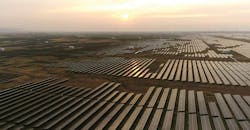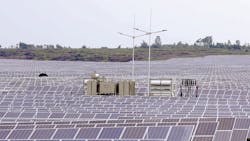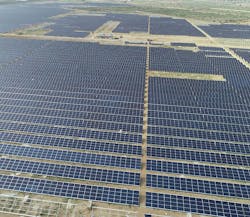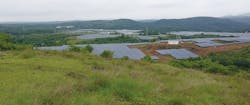India Moves to Renewables
India’s power sector has been based predominantly on fossil fuel power using mostly domestically mined coal to generate electricity. Since the country’s independence in 1947, there has been a rapid increase in installed generation capacity to keep pace with a rise in demand as a result of economic growth, rising population and rapid urbanization.
The utility electricity sector in India has one national grid with an installed generating capacity of 350 GW as of February 2019. As the world’s third largest producer and fourth largest consumer of electrical energy, the gross electricity consumption in India was 1149 kWh per capita in the year 2017-2018, which is relatively low per-capita electricity consumption compared to many countries despite the cheap electricity tariffs in India. The country faces challenges with its conventional power generation, including depleting coal reserves, difficulty procuring imported coal and long construction periods associated with coal-based power plants.
India was one of 194 countries with signatories in the Paris Agreement for the United Nations Framework Convention on Climate Change, establishing a pledge that 40% of its installed generation capacity will be based on renewables by 2030. Additionally, this will reduce the emission intensity of its gross domestic product by up to 35% by 2030. In view of the commitment to establish a healthy planet, a total of 175 GW of renewable energy generation will be installed by 2022. To date, a capacity of 75.05 GW already has been installed from different sources of renewable energy.
Solar Potential
Located in the high solar insolation region, India has huge solar energy potential. The Government of India has taken up renewable energy as an article of faith and set up an ambitious target to install 175 GW of renewable capacity by 2022. This includes 100 GW from solar, 60 GW from wind, 10 GW from biomass and 5 GW from small hydropower plants. Solar energy has a significant potential as a future energy source, but — equally important — it also has the advantage of enabling the decentralization distribution of electrical energy, thereby empowering people at a grassroots level.
To develop this opportunity, the Indian government launched the National Solar Mission (NSM) initiative in 2010 to promote ecologically sustainable growth and address the energy security challenge.
Prior to the launch of NSM, only 11 MW of solar capacity had been installed. However, after NSM launched and other state policies were put in place that encourage solar energy generation, the solar capacity has grown at a rapid pace. In the last five years, the installed cumulative capacity of solar projects has increased from 2632 MW in 2013-2014 to 21,651 MW in 2017-2018.
In India, most of the solar manufacturing capacity was either idle or operating at very low utilization rates, primarily because of the lack of scale, low-cost financing and underdeveloped supply chains. However, the launch of NSM revitalized solar manufacturing. In 2010-2011, the Central Electricity Regulatory Commission (CERC) project cost of solar photovoltaics (PV) was Rs16.90 Crore (US$ 2.43 million)/MW, based on PV module costs equating to US$2.2/Wp (watt peak) and a corresponding tariff of Rs17.91/kWh. In 2016-2017, the CERC project cost was Rs5.30 Croce./MW, based on PV module costs equating to US$0.48/Wp). The lower cost can be attributed to the reduced cost of PV modules coupled with advanced technology and a significant improvement in global supplies.
Solar tariffs are based on various factors such as location, solar irradiance in the state, availability of an attractive state policy for solar, availability of land, the cost of financing and the business environment, the willingness of distribution companies to purchase solar power and power evacuation infrastructure.
Pursuant to the successful bidding of solar projects under NSM, the solar projects being set up under the centralized or state process mostly are selected through tariff-based competitive bidding and reverse auction. This method of selection has lowered the solar average bid tariff significantly in both bidding and auctions, from a level of Rs17.91/kWh in December 2010 to about Rs2.44/kWh in May 2017, and repeated same 2.44/kWh in May 2018 in Bhadla Solar Park in Rajasthan.
The recent downward trends in solar tariff also may be attributable to factors such as economies of scale, assured availability of land, and power evacuation systems under the solar parks.
Solar Park Concept
The concept of a solar park in India was first conceived with the Charanka solar park in Gujarat. This was followed closely by the Bhadla Phase I solar park in Rajasthan. Solar power projects now can be established anywhere in the country. Solar project developers (SPDs) are obliged to identify and acquire the land along with all necessary statutory clearances required from the local state government, arrange other infrastructure facilities (for example, road, water and telecommunications) and construct the transmission infrastructure to connect the output of the solar park to the nearest grid substation. This process generally takes SPDs a long time to complete and all these procedures delay completion.
Solar projects in multiple locations lead to higher project costs per megawatt and increased transmission losses. Hence, the total cost of a solar project depends on multiple factors such as solar insolation at a site, infrastructure facilities required to be developed, logistics, cost of funding, prevailing prices of solar cells and modules, and related state government policies.
Solar parks can be instrumental in overcoming bottlenecks otherwise faced by independent power producers of solar PV projects. These can include land availability, developing the evacuation infrastructure, funding and other financial challenges. To overcome these challenges, an outline — or scheme — for the development of solar parks and ultra-mega solar projects was introduced in December 2014.
A solar park is a large contiguous stretch of land with high insolation levels. It provides proper infrastructure and access to amenities with minimal project risk for the developer. It also guarantees availability of land and transmission infrastructure facilities for setting up high-capacity solar projects, reducing the number of approvals required, minimizing the planning time for projects and thereby making provision for economy of scale and cost reduction while achieving a large-scale reduction in greenhouse gas (GHG) emissions. Additionally, solar parks provide road access, water (from a dedicated reservoir located on-site), a boundary fence and security; all these facilities would require a SPD to incur additional costs outside of a solar park.
750-MW Rewa solar park in Madhra Pradesh.
Each of these specialized services offer significant benefits to the SPD but come at a premium. Land plots within the solar park are more expensive than outside, but this premium is easily justifiable by the additional services, which are bundled into the land cost. However, the most important benefit from the park for a project developer is the significant time savings. The centralized single-window nature of the services within the park reduces the time between project conception and operations, translating into economic and real monetary gains for the SPD and the state.
The capacity of solar parks has been kept at 500 MW and above to achieve economy of scale cost reduction. However, smaller parks also can be set up in hilly areas where contiguous land may be difficult to acquire in view of the difficult terrain and where there is an acute shortage of nonagricultural land.
The power generated from individual projects is pooled to a nearby pooling substation. Each plot is interconnected with pooling substations through 33-kV or other suitable voltages by underground cables or overhead lines. The construction of this interconnection from the solar projects to the internal pooling substations in the park is the responsibility of the SPD.
Solar power park developers (SPPDs) also are responsible for the transmission system required to export the power from the solar park. This internal transmission system generally involves establishing a number of 33-kV/220-kV or suitable voltage-level substations inside the solar park and constructing a transmission circuit from these substations to connect to the nearest 200-kV/400-kV grid substation operated by the central transmission utility (CTU) or state transmission utility (STU).
Progress and Status
The Scheme for Development of Solar Parks was rolled out in December 2014 by the Government of India. The plan was to set up at least 25 solar parks, each with a capacity of 500 MW and above, thereby targeting around 20,000 MW of solar power installed capacity in a span of five years starting in 2014-2015. Smaller parks also are allowed in the Himalayan region and other hilly states where contiguous land is difficult to acquire because of difficult terrain as well as in states where there is an acute shortage of nonagricultural land.
To meet the demand for more solar parks from states, the capacity of the solar park scheme was increased from 20,000 MW to 40,000 MW in March 2017 for commissioning by 2012-2022. By the end of Jan 2019, 47 Solar Parks with a cumulative capacity of 26,694 MW was approved in 21 states.
Two solar parks with an aggregate capacity of 1680 MW, namely the Kurnool solar park (1000 MW) in Andhra Pradesh and the Bhadla Phase II solar park (680 MW) in Rajasthan, are fully operational. Furthermore, nine solar parks with an aggregate capacity of 3045 MW already are partially developed.
Bhadla Phase III solar park in Rajasthan with 500 MW in commission of the planned 1000-MW installation.
Case Studies
Operational since March 2017, the Kurnool solar park has generated around 240 million units of clean energy as of May 2018, resulting in a savings of 2.1 lakh tons (210,000 metric tons) of carbon dioxide emissions. With the commissioning of the 1000-MW capacity at a single location, the Kurnool solar park currently is the world’s largest solar park in commission, followed by the Longyangxia Dam solar park commissioned in China in 2016 with 850 MW of capacity.
With 2000 MW of capacity when constructed, the Pavagada solar park in Karnataka will be the second largest solar park of its kind, after the Tengger Desert solar park being constructed in Zhongwei, Ningxia, China. Known as the Great Wall of Solar in China, the Tengger Desert solar park will have an installed capacity of 1500 MW when complete.
Challenges and Issues
The solar park scheme aims to provide a huge impetus to solar energy generation by acting as a flagship demonstration facility to encourage project developers and investors, prompting projects of a similar nature, triggering economies of scale for cost reductions and technical improvements, and achieving large-scale reductions in GHG emissions. It enables states to bring in significant investment from project developers, meet the solar renewable purchase obligation (RPO) mandate and provide employment opportunities to the local population.
The key challenges for SPPDs are land, financing, grid integration, construction of the generation and transmission assets, forecasting solar generation and ancillary services. Acquisition of land for solar parks is one of the biggest challenges because the development requirement is between 4 acres and 5 acres (1.6 hectares and 2 hectares). Various state governments put favorable land policies in place that have been instrumental in reducing this problem.
Additionally, significant investment is required for the development of solar parks. This includes acquisition of land and the provision for necessary infrastructure, like road connectivity and transmission facilities. Investment also is required for operation and maintenance (O&M) of solar parks, employing staff and other activities like marketing.
Under the solar park scheme, the Government of India provides central financial assistance (CFA) of up to Rs20 lakh (US$ 28,735)/MW or 30%, of the project cost including grid-connectivity cost—whichever is lower—for the development of a solar park. While CFA covers only part of the park cost, the remaining amount is taken from SPDs as a one-time upfront charge and recurring O&M charges when they enter the park to set up solar projects. This financial model is being adopted for most of the solar parks.
In general, it is not possible to absorb the energy output from large-scale solar parks locally. The scenario is more prominent especially during the period of high solar generation at times when the local electricity demand is not at peak level. Transmission systems require planning for the integration of large-scale solar power parks with the state grid in addition to the interstate and national grid. This integration must ensure reliability of the power supplies to the whole system as a result of the intermittent nature of solar energy. The transmission capacity requirement for grid integration of solar parks also depends on the quantum of power to be transmitted or integrated. In addition to the in-service solar parks, when the planned solar park projects are in commission, an aggregate capacity of 40 GW will be connected to the transmission system.
The construction time for solar projects is less than 18 months while the transmission development for integration with the grid can take up to 36 months. Hence, transmission development for solar generation faces two critical issues: matching the implementation period and the transmission tariff. Therefore, a procedure is required to construct the transmission assets for high potential renewable energy
zones in anticipation of the development.
Solar generation forecasting and real-time monitoring are important tools to address the variability in and uncertainty of grid integration. State-of-the-art forecasting helps grid operators to manage power system balance for the economic, reliable and secure operation of the grid even with a high renewable energy penetration regime.
It is proposed the envisaged solar parks shall be integrated and connected to Renewable Energy Management Centers (REMC) located within the renewable energy-resources-rich states for monitoring, scheduling and forecasting purposes.
Ancillary services are defined as the services necessary to support the transmission of electrical energy from the seller to purchaser given the obligations of control areas and transmitting utilities within those control areas to maintain reliable operation of the interconnected transmission system.
The two most important services are the generating capacity required to support insufficient generation to maintain frequency and maintaining the voltage profile in the system.
50-MW solar park in Kerala.
Key Benefits
Solar parks have emerged as a powerful tool for the rapid development of solar power projects in India. Guaranteed availability of land and transmission infrastructure are the major benefits of a solar park. The recent downward trends in solar tariffs may be attributed to factors like economies of scale, guaranteed availability of land and power evacuation systems under the solar park scheme. Issues and challenges can be resolved through a concerted effort by all stake holders.
The major benefits of solar parks are as follows:
- 50,000 MW of solar projects can be set up in 50 proposed solar parks in various states in India.
- Availability of solar power at competitively low tariffs that, when operational, will generate 64 billion units of green electrical energy per year at 1.6 million units per megawatt.
- Achieving 40,000 MW of solar capacity would contribute to the long-term energy security of the country and ecological security by reducing carbon emissions as well as generating large direct and indirect employment opportunities in solar and allied industries like glass, metals and heavy industrial equipment.
- Installation of 40,000 MW of solar will lead to an abatement of around 56 million tons of carbon dioxide per year over its life cycle.
- It has attracted foreign players to invest in solar projects in India, and these investment opportunities will boost income.
- The solar parks also will provide productive use of abundant wastelands, which in turn facilitate development of the surrounding areas.
Acknowledgement
The authors wish to acknowledge the technical support and assistance given by Poonam Meena, of startup Dattatreya Maharaj Renewable Infra Project Consultancy Private Ltd., and Monika Singh, of the Shri Balaji college of engineering and technology at Rajasthan Technical University in Jaipur, India, in the preparation of this article.
About the Author
Dilip Nigam
Dilip Nigam worked in the private sector before joining the Government of India’s Ministry of New and Renewable Energy in 1987. He spent 16 years working on the country’s wind energy program and the last 14 years involved in the solar energy program. Nigam currently serves as an adviser for the National Solar Mission initiative dealing with schemes to promote solar power development.
Anindya Parira
Anindya Parira completed his master’s degree in physics at the University of Delhi, and has worked as a scientist in the Government of India’s Ministry of New and Renewable Energy for the last seven years. Parira has helped formulate policy and implement solar projects and parks across the country. His responsibilities include bilateral and multilateral financing of solar parks.
Sunil Kumar Gupta
Sunil Kumar Gupta has been a scientist at the Government of India’s Ministry of New and Renewable Energy for three years, and his principle role is contributing to the implementation of solar project across the country.



